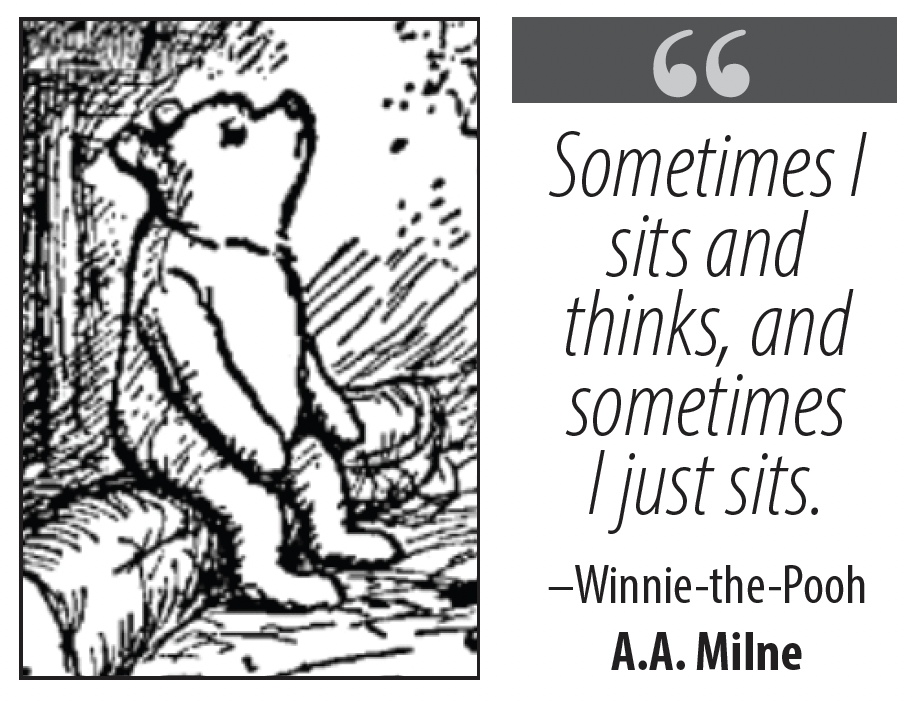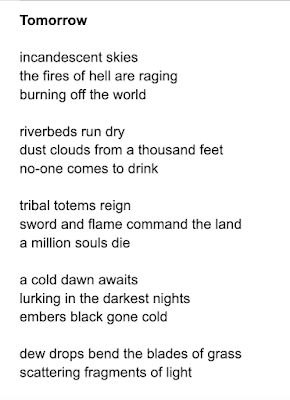When you take a look around, when you look hard at your own village, town, or city, there's a lot going on. In particular there's a lot going on that I would describe as creative endeavour. You'll find painters and poets and novelists and print makers and designers and photographers and inventors and cabinet makers and sculptors and wood turners and vintage car restorers and gardeners and experimental chefs and mural painters and dancers and guitarists and timpanists and .... yeah, there's a lot going on.
However all of us can all too easily fall under that 'fug' of feeling and thinking in which we think our world is not very creative, and that we are not very creative, because unless you are a part of that scene, or unless you actively go looking, you mostly don't see it.
Often on a daily basis we pass by the material evidence of this, with murals and sculptures in public spaces, or we might occasionally see a small media piece of a writers' workshop or something similar. And this is all part of the 'creative vibe' of any place in which we live. But I wonder how often we recognise it as such?
In politics we are now seeing an extreme example of the old lesson about repetition: if you say something often enough, whether truth or lie, people come to believe that it is so. Sadly we are seeing this all too often in the repetition of lies that are intended to create division, to appeal to some very base human instincts, in order to support someone's hunger for power. It is repetition based on a complete lack of moral imperative.
I have, during the course of experience in leading two schools, found that if you simply take what already goes on, are deliberate and intentional in giving those stories their creative spin, and tell the stories as widely as possible, you can influence a culture. You can raise awareness, you can get people to go 'oh wow yes, hadn't thought of that'. You can get people thinking about creativity, about what it looks like in their daily lives, in their daily mahi. You can build a creative vibe.
What if we harnessed this behaviour in support of the growth of creative and learning cities? What if we took what is already happening in our villages, towns, and cities, and kept talking about it, all the time? What if we were far more deliberate and intentional in telling our creative stories, and our learning stories, using social media as the amplification tool of the moment? Could we influence a city in this way? Could we convince people that they live in creative and learning focussed cities?
As I was part the way through writing this, the following piece appeared in the Star News (click on the link in the photo caption).
 |
| Source: https://www.odt.co.nz/star-news/star-christchurch/mini-melbourne-christchurch-nzs-new-capital-cool |
This is the creative vibe' I have been talking about, and this media piece is the sort of thing that builds the perception, and therefore the reality, of a creative city. After all, our perception is our reality, isn't it.
And why am I 'banging on' about a creative city? Because I have the opinion that a creative city is a learning city is a creative city is a learning city is a ... you get the idea. These are, I 'reckon', reinforcing concepts. The 'Manaiakalani kaupapa' with it's 'Learn Create Share' pedagogy shows us that creativity can be central to learning, and the work of Professor Peter O'Connor and so many others shows the impact on learning and wellbeing of taking a creative lens. Evidence shows for example that learning through a creative lens amplifies reading and writing for children.
There are so many opportunities. Take for example Jason Marsden, Centre Manager, at The Hub. He is delightfully passionate about connecting with the community and about being authentic. He initiated an 'artist in residence' at The Hub a few years ago, bringing creativity and creative opportunities to the local community. He's also a creative himself. Imagine what could happen if EVERY mall in the city did this. Imagine if every shopping mall hosted a' 'artist in residence'. What impact might that have?
There are a number of small entrepreneurial operators offering creative opportunities for young and old alike, whether 'Egg Academy', or Risingholme, or... far too many to name. What would happen if every mall in the city took it on itself to promote one of these operators every year, to have them operate within the 'public' spaces of the mall? Imagine the potential impact.
Perhaps the key word is 'IMAGINE'.... we don't allow ourselves to do that often enough.
The challenge is how to amplify the message, how to keep all of this wonderful creative mahi and energy, in front of as many people as possible, as often as possible.
This perhaps is some of the most important work of Ako Ōtautahi - Learning City Christchurch. AO-LCC is not a creator in the sense that it conceives and runs events etc, but rather a connector and an amplifier. The Trustees know the Gestalt that 'the whole is more than the sum of the parts'.
Going back to my experience in principalship, one of many things I think I learned is that you can change perceptions by focussing on the positive, by focussing on the great things that happen. One of the odd things about we humans is that if our 'information space isn't filled with positive news, we will most probably fill it with the negative. We all have that 'negative voice' in the back of our heads. We have to drown the negative out with positive ideas and thoughts. Our perception is our reality. So our challenge is, much like the principle of 'self talk', to flood the media spaces with positive stories of creativity and learning. We need to leverage off our many networks, social media and otherwise, with consistent and coherent messaging. We need to make sure that everyone from Frank and Lyn in Aranui to Hemi and Helen in Cashmere know about this. We can't afford to let a single drop of human creativity and potential go to waste.
We have to AMPLIFY AMPLIFY AMPLIFY.

























